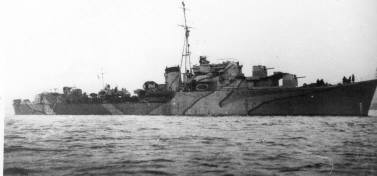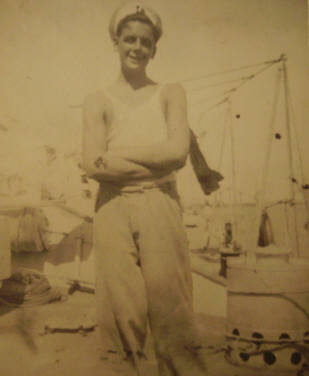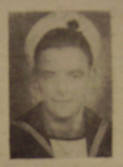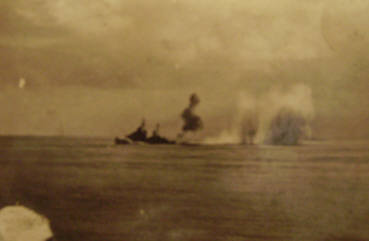Stoker 1st Class Bernard William Frank Lunnon
P/KX 135648, HMS Pakenham.
Born 19th July, 1924. Died 16th April 1943, aged 19.
Bernard was born in Woburn Sands, one of at least seven children of William and Phyllis. His parents lived on Woburn Road. He worked as a labourer before the War, working on Birchmoor Pumping Station and as a plasterer.
He joined the navy on 22nd September, 1941, and joined HMS Pakenham, a “P” class Destroyer, on 19th January, 1942. HMS Pakenham was the Leader of the 12th Destroyer Flotilla. In March, it went to Durban, before heading back to the Mediterranean.
HMS Pakenham was involved in a famous action that resulted in the capture of an Enigma machine, which enabled Bletchley Park to decipher coded enemy messages.
On the night of 30 October 1942, a British destroyer, HMS Petard, caught U-559 sneaking up on a convoy off the coast of Egypt. Petard, joined by HMS Pakenham, HMS Dulverton and HMS Hurworth attacked U-559, dropping depth charges which cracked her pressure hull. With four of her crew dead from the explosions and flooding, U-559 was forced to the surface. Convinced that their boat was sinking, the German crew scrambled overboard in panic, and neglected to destroy their codebooks or Enigma machine. The Germans were collected by British ships, and hastily hustled below decks, so they could not see what was to follow. Three British sailors, Able Seaman Colin Grazier, Lieutenant Francis Anthony Blair Fasson, and NAAFI canteen assistant Tommy Brown, then swam naked to the abandoned submarine which was slowly sinking. They retrieved the boat’s Enigma machine and the code books with all current settings for the U-boat Enigma key. Grazier and Fasson were inside the boat, searching for more cipher and intelligence material, when the boat foundered. Both were drowned. This Enigma material they retrieved was immensely valuable to the code-breakers at Bletchley Park, who had been unable to read U-boat Enigma for nine months. The captured material allowed them to read U-boat Enigma for several weeks, and to break U-boat Enigma thereafter. Wikipedia
In January, 1943, it sunk the Italian submarine Narvalo, and another six ships including the Agosto Bertani and the Stromboli.

HMS Pakenham was a “Paladin” Class Fleet Destroyer ordered from Hawthorn Leslie Newcastle on 2nd October 1939 with 2nd Emergency Flotilla. She was laid down on 6th February 1940 and launched on 28th January 1941 as HMS Onslow but in August 1941 her name was changed to Pakenham. The ship was fitted with additional accommodation for use as the Leader of a destroyer flotilla. Build was completed on 4th February 1942 at a cost of £416,710, excluding Admiralty supplied equipment such as guns and communications equipment. After a successful “Warship Week” National Savings campaign during March 1942 she was adopted by the civil community of Wallasey, then in the county of Cheshire.HMS Pakenham
(Image courtesy of Terry Dickens – WorldNavalShips Forum)April 16th 1943…. Deployed with HM Destroyer Paladin south west of Marsala and intercepted convoy escorted by Italian torpedo boats Tifone, Climene, Cigno and Cassiopea. Engaged Italian torpedo boats Gigno and Cassiopea. The convoy escaped with the other two escorts. Sank Cigno by torpedo after vessel disabled by surface gunfire. Hit four times by return fire and sustained major damage with some flooding in Engine Room. Disabled and taken in tow by HMS Paladin but operation had to be abandoned due to threat of air attacks. Ship’s company taken off by HMS Paladin before being sunk by torpedo in position 37.26 North 12.30 East off Cape Granitola. “Service Histories of Royal Navy Warships in World War 2” by Lt Cdr Geoffrey B Mason RN (Rtd) at www.naval-history.net
A first-hand account of this action by Rex Houghton has been uploaded to the BBC Peoples War project:
“We had just sunk a destroyer and couple of other ships when we were hit by gunfire. The portside was hit and the engine room was badly damaged and a lot of the engine room personnel were killed or very badly scalded by escaping steam…..We had lost all power and were dead in the water. The HMS Paladin tried to tow us but it wouldn’t work so in the end an order came from Malta to sink the ship. This was done using torpedoes. We abandoned ship by getting onto the HMS Paladin and we could only take what we could very quickly carry, it was the 16th April 1943.” www.bbc.co.uk/ww2peopleswar


The official record says that at 0248 hours they encountered two large Italian Destroyers in the Sicilian Narrows, 15 miles south of Marritimo. At 0300, HMS Pakenham was hit 4 times. It had been taken in tow 45 minutes later, and made 5 knots for 2 hours, before being bombed by aircraft at 37″ 28′ N, 12″ 32’S. British fighter aircraft gave cover for the removal of the crew, then HMS Paladin sunk it.
In total, 11 of the ships company were killed during this action, including Bernard. His death was reported in the Woburn Reporter on 18th May, 1943, saying he had been on active service for 14 months. Bernard is listed on the Portsmouth Naval Memorial.


After the First World War, an appropriate way had to be found of commemorating those members of the Royal Navy who had no known grave, the majority of deaths having occurred at sea where no permanent memorial could be provided. An Admiralty committee recommended that the three manning ports in Great Britain – Chatham, Plymouth and Portsmouth – should each have an identical memorial of unmistakable naval form, an obelisk, which would serve as a leading mark for shipping. The memorials were designed by Sir Robert Lorimer, who had already carried out a considerable amount of work for the Commission, with sculpture by Henry Poole. After the Second World War it was decided that the naval memorials should be extended to provide space for commemorating the naval dead without graves of that war, but since the three sites were dissimilar, a different architectural treatment was required for each. Portsmouth Naval Memorial commemorates 9,667 sailors of the First World War and 14,918 of the Second World War. Commonwealth War Graves Commission.
My grateful thanks to the Lunnon family for providing the details here and the images, unless otherwise attributed.
Page last updated Jan. 2019.
